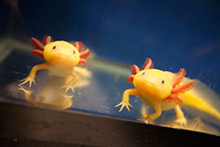
The axolotl, a rare and unusual salamander native to Mexico, has the ability to regenerate an amazing variety of body parts, including entire limbs and even brain tissue. Photography by Brian Connors Manke.
How are some animals able to regrow body parts following injury? Why can’t humans do the same thing? Can scientists learn the secrets that imbue certain animals with this amazing ability? Could that knowledge someday be used to develop new therapies to help people, including those who have lost limbs?
Four professors in the University of Kentucky Department of Biology-S. Randal Voss, PhD; Jeramiah Smith, PhD; Ann Morris, PhD; and Ashley Seifert, PhD-are undertaking the basic scientific research needed to begin to answer these and other questions.
At its base, vertebrate regeneration requires a complex molecular crosstalk between cells, similar in many ways to the cellular “communication” that occurs in the development of an animal from a single cell to an adult organism. Certain genes are activated or deactivated at specific times to turn undifferentiated cells into tissues and organs, and to arrange them into complicated body parts such as limbs and joints.
By studying the genetic mechanisms that enable regeneration in others, scientists hope to one day uncover potentially latent healing abilities that may lie hidden in our own genome.
Smith is a genomics expert who works with sea lampreys. These jawless, eel-like creatures have the ability to regenerate spinal cord cells, which is a neat trick for any vertebrate.
Smith also works closely with Voss, sequencing the genome of salamanders. Voss’ research focuses on axolotls, an unusual type of salamander that lives wild only in one tiny part of Mexico. Unlike most salamanders, which undergo a metamorphosis from larva to adult, axolotls retain their juvenile form throughout their entire lifespan. But the main reason that axolotls are among the most-studied salamanders in the world is their amazing ability to regenerate a variety of body parts.
“It’s hard to find a body part they can’t regenerate,” Voss said. “Salamanders in general, and axolotls especially so. The limbs, the tail, the spinal cord-even half of their brain has been removed and shown to regenerate.”
Voss’ research involves assembling a vast store of genetic data from regenerated axolotl tissue. From this data, Voss will elaborate a model for how genes are turned on and off over very small timescales.
Another vertebrate-the zebrafish-has the ability to regenerate an impressive variety of different tissues. This minnow-like freshwater fish is central to the research of Morris, who is interested specifically in its ability to regenerate retinal cells-an ability we humans lack.
The structure of the retina and the types of cells found therein are similar across all vertebrates. By studying how the retina develops in zebrafish embryos, Morris said researchers can learn a great deal about how the process works in mammals, and specifically in humans.
An oft-repeated maxim in biology classrooms is that “regeneration recapitulates development.” So, if our retinas are so similar in their development, how is it that zebrafish can regenerate retinal cells and we can’t? The answer, according to Morris, is suspended between two distinct possibilities.
“One is that at some point, everybody had the ability to regenerate, and that ability in certain lineages was eventually lost,” Morris said. “So, perhaps all the mechanism is still there in the genome, and it just needs to be reactivated. The other is that as these different vertebrate lineages diverged, certain vertebrates evolved that ability whereas others didn’t. I happen to believe it’s probably more of the former-that some of those abilities are there and they’re latent, and we have to discover how to reactivate them.”
One possibility is that mammals essentially “traded” much of their regeneration ability in developing adaptive immune systems. Animals that excel at regeneration tend not to exhibit the same responses to injury that mammals do-such as inflammation and scar formation-and mammals generally lag far behind other vertebrates in their ability to regrow missing parts.
That’s what makes the African spiny mouse, a sort of master of regeneration in mammalian circles, so remarkable. Seifert, whose research is focused on skin regeneration, started studying these animals about five years ago.
“What’s phenomenal is that they’re able to regenerate complex tissue structures,” Seifert said. “They can regenerate all of the components of their skin including hair follicles, sebaceous glands, and the underlying dermis, the structural component which gives the skin strength. And then, in the ears, amazingly, they can regenerate cartilage. Any orthopedic surgeon will tell you what a huge advance it would be if we could figure out how to regenerate cartilage in a mammal.”
If these researchers can find a way to make the regeneration of cartilage, skin, and bones a reality, it could change the lives of countless amputees around the world.
Will it happen?
Only time will tell.
This article was adapted with permission from an article by Keith Hautala of the University of Kentucky, Lexington.




